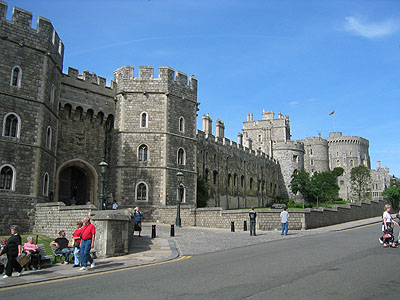
RBH Home
Maps & Travels
Articles
Legends
Towns & Villages
Castles & Houses
Churches
Biographies
Gentry
Family History
Odds & Ends
Mail David
 Windsor Castle
Windsor CastleEarliest Norman Fortification
Prior to the Norman Conquest, the
manor of Clewer, the site of modern
Windsor, consisting of five hides, was
the property of King
Harold, son of Godwin, and, together with his other estates, fell
at his death into the hands of William
the Conqueror. William granted the manor to one Ralph, the
son of Seifride, reserving, however, one-half of a hide on which are
believed to have been some ancient earthworks and on which he built for
himself a castle. This was styled, not Clewer Castle, but Windsor Castle,
the name of Harold's Royal residence nearby (at what is now called Old
Windsor). Since then, the castle has been intimately associated with English history, having been used
alternately by William's descendants as their palace, prison and burial
place.
William
Rufus assembled a council at Windsor and, there, imprisoned the
rebellious Earl of Mowbray for the remaining thirty years of his life. Henry
I built a chapel, probably on the site now occupied by the Albert
Memorial Chapel, formerly known as Wolsey's Tomb House. Windsor was a
favourite summer residence of Henry and it was there, in 1121, that he
married Adelicia of Louvain, the 'Fair Maid of Brabant.' In
1127, Henry received, at Windsor, the homage of the nobles of the land who,
at the same time, swore allegiance to his daughter, the Empress
Matilda. As was usual on such solemn occasions, the coronation
ceremony was repeated.
Windsor does not figure at all in King
Stephen's
disturbed reign but it was seen as one of the key Royal castles to be
handed over to Henry
II upon his succession. The latter frequently resided there and,
in the tenth year of his reign, expended the sum of 30s on repairing the
Royal kitchen. Fabyan,
a chronicler of the time, tells a pathetic story bearing on Henry's
domestic troubles with his rebellious sons. "It is recorded that in a
chamber at Windsor, he caused to be painted an eagle, with four birds,
whereof three of them all raised [scratched] the body of the old
eagle, and the fourth was scratching at the old eagle's eyes. When the
question was asked of him [Henry], what thing that picture should
signify? It was answered by him, "This old eagle," said he,
"is myself; and these four eagles betoken my four sons, the which
cease not to pursue my death, and especially my youngest son, John, which
now I love most, shall most especially await and imagine my death.""
Prince John
garrisoned the Windsor Castle against William
Marshal and the supporters of his brother, King Richard,
in 1193 and it is closely connected with his granting of Magna Carta. Between Old Windsor and Staines is the flat meadow of
Runnymede, from which the castle towers are visible. During the
conferences which preceded and followed the ratification of this great
charter, John went backwards and forwards to Windsor Castle each day. He was at
Windsor when he heard of the invasion of the French Dauphin, Louis, in
1216. The King later moved elsewhere but the castle was put under siege for
two long months by the rebel Barons and their French allies.
Part
2: Early Medieval Expansion
Edited from PH Ditchfield's "Bygone
Berkshire" (1896)
